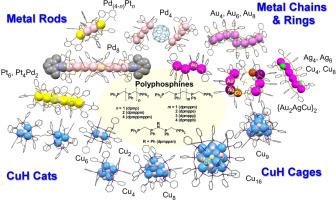Coordination Chemistry Reviews ( IF 20.6 ) Pub Date : 2022-05-12 , DOI: 10.1016/j.ccr.2022.214581 Tomoaki Tanase 1 , Kanako Nakamae 1 , Yasuyuki Ura 1 , Takayuki Nakajima 1

|
Structurally constrained multinuclear metal assemblies are fascinating building blocks for atomically precise nano-structured molecular devices with a variety of functions from electronic, magnetic, photophysical, and catalytic properties arising from cooperative effects of proximate metal centers. Finely tuned structures and electronic states of metal assemblies are in debt to design of multidentate guiding and supporting ligands, and aiming to develop low valent metal assemblies as molecular miniatures of metallic materials, those with a pair of soft donors connected by a single atom, namely, bearing short bite units, are highly desired. In this regard, this review surveys the studies over a couple of decades on multinuclear metal complexes constrained by linear and branched tri-, tetra-, and polydentate phosphine ligands with short bite distances between the two donor atoms possessing P3, P4, and P6 donor sets. Those with mixed donor phosphines having PCP, PNP, PAsP, PNNP, and N(P3) donor sets, are also explained because the hetero soft donors of carbene, imino-nitrogen, and arsine enable fine stepwise syntheses of heterometal assemblies through metallomacrocyclic and metallocage precursors. Multinuclear complexes supported by non-phosphino multidentate ligands and by mono- and diphosphines are not included. This contribution focuses not only on 1D metal chains but on other 2D and 3D topological arrangements, and in particular, highlights the recently developed Pt and Pd based metal strings organized by linear tri- and tetraphosphine ligands, photo- and electroluminescent coinage metal assemblies in linear, ring, planar, and polyhedral metal arrangements, and copper hydride multinuclear complexes showing attractive hydride reactivity. These compounds of subnano- to nano-scaled building blocks will provide useful platforms to develop further assembled nano-molecular devices with structurally and atomically controlled synthetic strategies.
中文翻译:

受多齿膦配体约束的微调金属组件
结构受限的多核金属组件是原子级精确纳米结构分子器件的迷人组成部分,具有多种功能,包括电子、磁性、光物理和催化特性,这些功能由邻近金属中心的协同作用产生。金属组件的精细调谐结构和电子状态得益于多齿引导和支持配体的设计,旨在开发低价金属组件作为金属材料的分子缩影,即具有一对由单个原子连接的软供体,即,轴承短咬合单元,是非常需要的。在这方面,本综述调查了几十年来关于受线性和支链三、四、3、 P 4和 P 6供体组。具有 PCP、PNP、PAsP、PNNP 和 N(P 3 ) 的混合供体膦) 供体组也得到解释,因为卡宾、亚氨基氮和胂的异质软供体能够通过金属大环和金属络合物前体精细地逐步合成异质金属组件。不包括由非膦基多齿配体和单膦和二膦支持的多核配合物。这一贡献不仅关注一维金属链,还关注其他二维和 3D 拓扑排列,特别强调了最近开发的由线性三膦和四膦配体组织的 Pt 和 Pd 基金属串,线性光致和电致发光硬币金属组件、环状、平面和多面体金属排列,以及氢化铜多核配合物,显示出有吸引力的氢化物反应性。


























 京公网安备 11010802027423号
京公网安备 11010802027423号